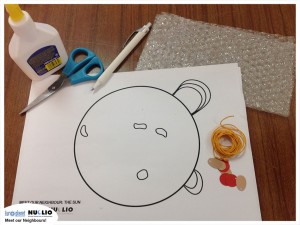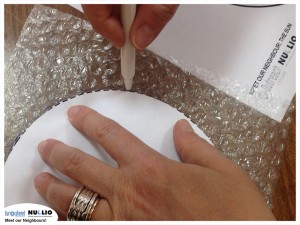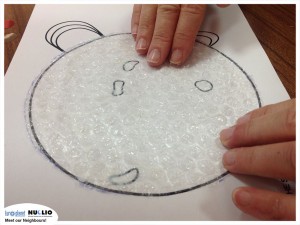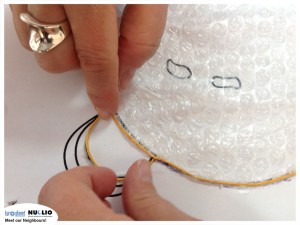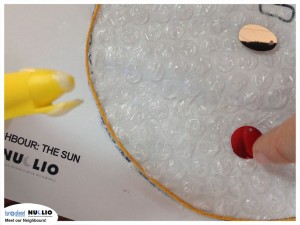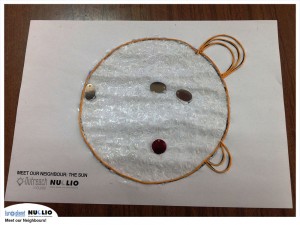:: Description ::
In this activity groups of visually impaired students and their sighted peers are invited to use daily basis items and recycled materials to build a tactile schematic image of a celestial object from our solar system. In a group activity, they are also encouraged to research about our celestial neighbour and its main characteristics.
This activity is planned for groups of children from 6 to 12 years old, and their educators gathered in groups of 3 to 5 children (for example 3 sighted children and two visually impaired). The activity can be implemented at three stages that can be done separately:
- Research on the celestial object by the children prior to the activity;
- Build the tactile image in a hands-on performed by the sighted children closely interacting with their visually impaired peers;
- Tactile exploration of the final schematic image by visually impaired children.
:: Materials ::
Tactile features present in the Sun and correspondent suggested textures:
- Surface of the sun: fabric of granular texture or bubble paper;
- Sunspots: sequins;
- Prominence and sun outline: thin thread;
- Black and white prints of image (x2) and mold (x1). Click links to Download.
These materials are only suggestions; all textures can be replaced by local low-cost materials from each community that plans to implement “Meet our Neighbours!”.
:: The Scientist Explains ::
[General Information]
The Sun is a star called “yellow dwarf”, of average dimension and mass much like many others in the universe. Its diameter is about 1,400,000 km, which means that more than 100 Earths could be lined up along the Sun’s equator, and its mass is more than 300,000 times that of Earth. But compared to other types of stars, the Sun is quite average: the radius (mass) of the smallest type of stars, called “brown dwarfs”, can be as low as 0.05 solar radius (0.01 solar mass) whereas that of the largest type of stars, called “supergiants” or “hypergiants”, can reach 1000 solar radii (200 solar masses).
The Sun produces its energy from thermonuclear reactions taking place at its very centre, where the temperature reaches 15 million degrees. This process, which involves “burning” hydrogen and transforming it into helium, has been going on for the last 4.5 billion years and is expected to last about the same amount of time.
The sun has an atmosphere, called the “chromosphere” because of its dark orange colour. It can only be seen during natural or artificial eclipses as a thin orange layer around the much brighter photosphere. Finally, above the chromosphere, lies the “corona”, a region containing very rarefied gas heated up to one million degrees by a process that is still poorly understood.
[Tactile features]
[While you explore the tactile schematic image you can find:]
Sunspots
The surface of the Sun called “photosphere”, is much cooler than its core, with a temperature of 5500°C. At certain locations on the photosphere, called “solar spots” or “sunspots” the temperature is lowered by about 1000°C. This makes them appear darker than the surroundings. (materialized by the four irregular shaped areas on the tactile image). The activity of the Sun can be measured by the number of spots appearing on the photosphere during a particular year. This activity varies periodically along a cycle of about 11 years.
Granulation
Also on the photosphere there are granules [the bubbling texture on the surface of the sun]. These granules are formed when the rising bubbles of hot material (plasma) surfaces and cools down and descends again in a heating process that the scientists call convection, a heating distribution process that happens on a bubbling hot water pan.
Solar Prominences
Other remarkable features of the sun are the “solar prominences” (materialized by loops of thread at the edge of the tactile image). They are actual bridges of matter between sunspots. Some of them can be lifted above the photosphere by as much as 350,000 km, which is almost the distance between the Earth and the Moon. They can also be completely disrupted by violent explosions before all the matter has time to fall back onto the surface, in which case some of the matter is sent flowing throughout the solar system.
:: Full Activity Description ::
Prior to the activity:
- Gather the children in groups of 3 to 5 elements – visually impaired and non-visually impaired (for example 3 non-visually impaired to 2 visually impaired);
- Present one image per group;
- Distribute materials accordingly;
During the activity:
- Close supervision – follow each group and explain each of the tactile elements and their correspondence to the each object feature;
- Understand the different needs of each group of students to promote interaction between the children during the building of the tactile image – visually impaired children need to be familiarized with the different materials involved;
Building the tactile image:
STEP 1: Print 01_Sun_Image and 01_Sun_Mold images, in a regular black and white printer;
STEP 2: Cut 01_Sun_Mold dashed image and place it on top of the fabric, then with a pen outline the shape;
STEP 3: Cut the fabric accordingly to the area outlined;
STEP 4: Place abundant glue on 01_Sun_Image, correspondent to the cut area;
STEP 5: Place the fabric on top of the glue;
STEP 6: Glue the thin thread of plastic along the outer shape of the Sun;
STEP 7: Glue the thin thread of plastic to the prominence features.
STEP 8: Glue the different sequins on top of the glued fabric in 01_Sun_Image;
Note: Please wait for the image to dry. It may take a while before you can start exploring the image.
:: Exploring the tactile image ::
There are several ways in which you can explore the scientific content of the tactile schematic images.
If you’re presenting the final tactile image to the children, first let them explore and feel the different textures. Questions will arise as the child explores and it is important to guide them. Read “The Scientist Explains” to understand the different features present in the Sun’s schematic tactile image.
(1) The star’s outer shape is outlined by a thin thread. Follow the thread until you find (3) the solar prominence. (2) Feel the interior of (1) the thin thread. This is the sun’s surface. There are several (5) sunspots present.
